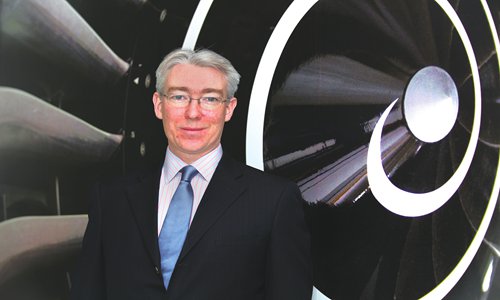
Patrick Horgan, regional director for Northeast Asia of Rolls-Royce plc Photo: Courtesy of Rolls-Royce plc
"We are best-placed to support China in achieving sustainable development through technological innovation and partnership, and we've been part of the Belt and Road (B&R) initiative supporting Chinese companies in the air, on land and at sea," a senior executive from Rolls-Royce plc (RR) said on Tuesday.
Patrick Horgan, regional director for Northeast Asia of RR, made this comment during the Belt and Road Forum in Beijing, which ended on Monday.
As one of the world's leading engineering companies providing mission-critical power and propulsion solutions for a variety of industrial applications, RR has been powering China's industrial development for more than five decades across multiple sectors, including civilian aerospace, civilian nuclear, power systems and marine.
There are 400+ RR-powered wide-body aircraft in China, and 20 percent of its renowned Trent engines are delivered to Chinese operators. Trent 700 engines power close to 90 percent of China's Airbus 330 fleet with a number of airlines for both domestic and international routes.
RR has been selected as the preferred bidder by EDF on different areas of work at UK's Hinkley Point C project, a nuclear power plant to be built with joint investment by a Chinese consortium led by China General Nuclear Power Group.
In China, RR has been supplying safety-critical instrumentation and control systems since 1994 when the Qinshan and Daya Bay nuclear power plants were opened. Earlier this year, the company formed a joint venture with Guangxi Yuchai Machinery for the localization of MTU Series 4000 diesel engines for power generation and oil and gas applications in China and Southeast Asia.
Under Rolls-Royce Power Systems, MTU has been a long-term supplier of China Railway, with its MTU Series 4000 engines intended to power nearly 500 locomotives in different regions along the B&R initiative, he said.
Global Times reporter Tu Lei (GT) talked with Horgan about his views on the initiative and challenges the company faces.
GT: What is the difference since the B&R initiative was launched years ago compared with earlier years?
Horgan: Over the past few years, international activities along the B&R have increased significantly, with Chinese companies' investments getting more diversified.
This has been a steadily increasing process over the past few years, and I hope and expect the initiative can drive in an open way to create the opportunities, not just for the places proceeding the infrastructure, but for the communities, companies and countries having the expertise to support the projects.
GT: What are the challenges for RR in the initiative?
Horgan: I think the challenges are not just for us as a company, but for the projects of this massive scale. The initiative covers many physical areas as there are national borders to cross, with regulatory and cultural differences. For example, in some areas, the population is relatively low, and the demographics are not too helpful.
In order for the investments to be successful and sustainable, it's necessary for people to benefit and businesses to make returns on their investments.
GT: Do you plan to cooperate with COMAC, the producer of the C919?
Horgan: Yes, we have regular communication with COMAC at all levels - technical, operational and at the top level.
We have world-class engine products for wide-body aircraft with remarkable engineering and outstanding services. We hope an excellent aircraft will be equipped with our excellent engines.

